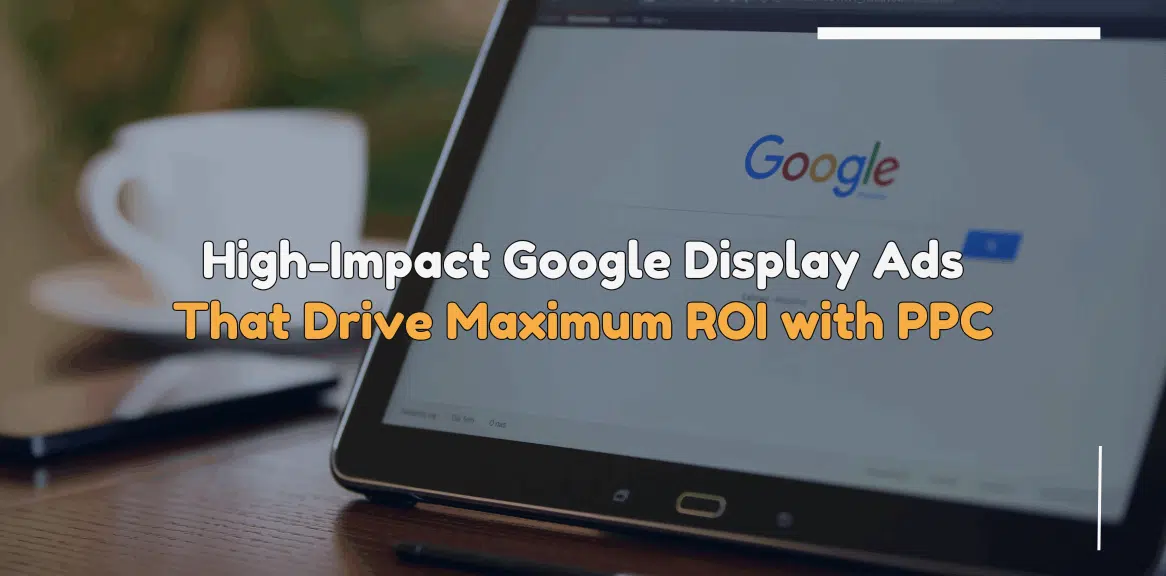Today, in our fast digital world, firms look to grab more views, more leads, and most key—more gains from their ad money. One of the top ways to hit all three is using Google Display Ads. These visual ads let you reach over 90% of people online all over the world. They are a must in any sharp marketing plan.
Yet, not every display ad run works the same. Some just eat your cash with little back, while others build strong brand looks and get lots for a low cost. Knowing how to create effective display ads that look great and drive real ROI is key.
Let’s dive into how Google Display Ads work and how to use them to push your PPC marketing results up.
What Are Google Display Ads?
Google Display Ads are visual ads that show up across a vast network of over two million sites, YouTube, apps, and Gmail. Unlike search ads, which pop up when someone types a word in Google, display ads appear as users browse the net, watching videos, reading, or checking emails.
They are great for making your brand known, pushing messages, and even turning users who are still thinking about buying. These ads vary from still images and rich media to videos and fun banners. Google hooks you up with Responsive Display Ads, too, which shift in size and look to fit different spots on the web. This makes sure your brand shows right and grows.
Why Are Google Display Ads Essential for ROI-Focused PPC Campaigns?
Only Google Search Ads pull in direct ROI because they catch high intent. However, Google Display Ads also play a significant role—they generate demand, nurture leads, and keep your brand visible throughout the buyer’s journey. A big plus of display ads is that they cost less per click than search ads, letting you reach more folks without breaking the bank. They also allow you to catch past site visitors again, which ups your chances of making a sale.
For example, if a user almost bought something but quit, you can show them ads with just what they looked at—this is called dynamic remarketing, and it can boost PPC ROI with display ads. Along with sales, display ads raise brand memory and buyer loyalty. With good-looking ads on big sites, you plant your brand in people’s minds well before they need what you sell. When do they start to search? They know you already.
The Anatomy of a High-Impact Display Ad
To make ads that do well, dig deep into knowing your audience and create a campaign that fits their wants, likes, and online ways. Aiming at the right audience is the base of a good display run. Google lets you target folks by age, interests, online behavior, and even their recent search moves. If you sell running shoes, for example, you could aim at those keen on long races or fitness blogs. You can also use remarketing to touch those who’ve been to your site or app before, giving them ads that spark their interest again.
Once your audience is set, your ad must sing. The look should catch the eye, but also match your brand style. Clear, sharp images, colors that fit your brand, and a clean setup are the key to a solid first look. Your ad should guide eyes to the big message, like your main line, deal, or action button.
Speaking of which, your call to action (CTA) should be clear. Phrases like “Shop Now,” “Get 20% Off Today,” or “Start Your Free Trial” work better than a plain “Click Here.”
Also crucial is your writing. Your headline and details should be clear, packed with benefits, and pull in your reader. Miss the fluff, get to the point. For instance, “End Back Pain in 7 Days” works better than “Check Our Back Support Gear.”
Why Is Mobile Optimization Non-Negotiable?
In a mobile-first age, shaping your display ads—and your landing pages—for phones and tablets is a must. Much of the impressions now come from mobiles, and if your ad doesn’t look good on them or your page is slow, you’re likely losing sales.
Ensure your visuals shine on small screens and your text is easy to read without zooming. Your landing page should be simple to use, with fast loads, easy-to-click buttons, and a smooth buy or contact process. Use tools like Google’s PageSpeed Insights to check your mobile page speed and get tips to do better.
The Power of Testing and Continuous Optimization
Creating a high-performing display ad campaign doesn’t end at launch—it’s only the beginning. The most successful marketers are those who constantly test, measure, and refine their ads based on real-time data. A/B testing different versions of your ad can help identify what resonates most with your audience. Try testing variations of your headlines, descriptions, CTA phrases, images, or even background colors.
Don’t just rely on surface-level metrics like impressions or clicks. Dig deeper into your click-through rate (CTR), conversion rate (CVR), bounce rate, cost per conversion, and the time users spend on your landing page. If your CTR is high but conversions are low, it might indicate a disconnect between your ad and landing page messaging.
If bounce rates are high, your landing page may need optimization. Use pay-per-click management tools like Google Ads Reports and Google Analytics to gather these insights and adjust your campaigns accordingly.
Advanced Techniques to Maximize PPC ROI
To level up your Google Display Ads, try out smart moves like dynamic remarketing. This lets you show users ads with products they saw on your site. It makes your ads more to the point and helps lift your conversion rates. Try using similar audiences, too. Google finds users who act and look like your current shoppers. It’s a great way to grow your efforts while still nailing your target.
Also, put caps on how often your ads show to the same person. This stops users from seeing your ads too much, which helps prevent them from getting bored and ignores wasted views. It’s smart to check the best days and times for your ads, too, and plan your ads at these times. Using innovative bidding tools like Target CPA or Maximize Conversions can push up your ROI. Google’s AI changes bids in the moment based on the chance of getting a conversion.
A Real-Life Example of Display Ad Success
Take a skincare brand launching a line of organic moisturizers. They start targeting people who have looked at similar items and those searching for skincare routines online. They make simple, clean ads showing the product and a discount—”Save 25% on Our New Organic Line.”
The page for this is excellent on mobile and shows why the product is good, customer thoughts, and a quick way to buy. They run many ad types and test different headlines and CTA buttons. In the end, they see a 40% rise in site visits and make 3.8 times what they spent on ads, all thanks to sharp targeting, top-notch ads, and ongoing tests.
Common Pitfalls to Avoid
Even though display ads are strong, some pitfalls can pull down your campaign. One mistake is targeting the wrong folks, which leads to ads that don’t connect and lose money. Also, making your ads too busy or unclear will make people skip them.
Not making your site suitable for mobile is another big no-no, more so as most internet users are on mobile. Failing to conduct A/B tests or utilize data can result in campaigns that underperform and fail to improve. Lastly, vague or common CTAs like “Click Here” can lower how much people engage.
Final Thoughts
Google Display Ads are more than just online signs. They’re strong ways to share your story, get new buyers, and make your brand big. From hitting the right people and making your ads pop to making sure they’re great on mobile and testing the right way, every bit helps make sure your campaign works well.
Key Takeaway: Focus not just on being seen, but on being spot-on and giving a good experience. Tune your ad message with what users want, make every part—from your ads to your page—significant, and keep tweaking your plan based on what the data tells you.
At Eco York, we’re all about putting together strong, data-led display ad tactics that truly give you good ROI. Let us help turn each click into a customer, whether it’s through display, search, or even social media marketing. Contact us at Eco York today to learn more!





